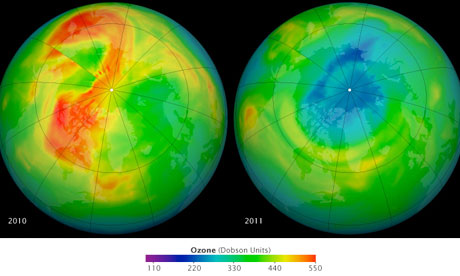
This chart shows the levels of ozone above the Arctic on 19 March 2010 (left) and 2011 (right), the latter showing about a 50% drop. Photograph: OMI/Aura/NASA
A huge hole that appeared in the Earth's protective ozone layer above the Arctic in 2011 was the largest recorded in the northern hemisphere, though the sudden appearance of the hole was not due to man-made causes, scientists said in a report on Monday.
The ozone layer high in the stratosphere acts like a giant shield against the sun's ultraviolet (UV) radiation, which can cause skin cancer and cataracts. Since the 1980s, scientists have charted the size of the ozone hole every summer above the Antarctic.
Some years, the holes have been so large that they covered the entire continent and stretched to parts of South America.
During extreme events, up to 70% of the ozone layer can be destroyed, before it recovers months later. The hole above the Arctic was always much smaller – until March this year, when a combination of powerful wind patterns and intense cold temperatures high up in the atmosphere created the right conditions for already-present, ozone-eating chlorine chemicals to damage the layer.
The findings, reported on Monday in the journal Nature, show that the hole had opened over northern Russia, parts of Greenland, and Norway, meaning people in these areas were likely to have been exposed to high levels of UV radiation.
"The chemical ozone destruction over the Arctic in early 2011 was, for the first time in the observational record, comparable to that in the Antarctic ozone hole," say the scientists, led by Gloria Manney of the Jet Propulsion Laboratory in Pasadena, California.
The scientists say man-made chemicals such as chlorofluorocarbons (CFCs) destroy ozone in the stratosphere, after sunlight breaks up the complex chemicals into simpler forms that react with ozone. While some of the chemicals are covered by a UN treaty that aims to stop their use, it will be decades before they are fully phased out of production.
Normally, atmospheric conditions high above the Arctic do not trigger a large-scale plunge in ozone levels. But during the 2010/11 winter, a high-altitude wind pattern called the polar vortex was unusually strong, leading to very cold conditions in the stratosphere that also lasted for several months. This created the right conditions for the ozone-destroying forms of chlorine to slash ozone levels over a long period.
The report's authors said there was a risk that the spread of the Arctic hole could become an annual event.
taken from http://www.guardian.co.uk/environment/2011/oct/03/arctic-ozone-layer-hole-expands
The ozone layer high in the stratosphere acts like a giant shield against the sun's ultraviolet (UV) radiation, which can cause skin cancer and cataracts. Since the 1980s, scientists have charted the size of the ozone hole every summer above the Antarctic.
Some years, the holes have been so large that they covered the entire continent and stretched to parts of South America.
During extreme events, up to 70% of the ozone layer can be destroyed, before it recovers months later. The hole above the Arctic was always much smaller – until March this year, when a combination of powerful wind patterns and intense cold temperatures high up in the atmosphere created the right conditions for already-present, ozone-eating chlorine chemicals to damage the layer.
The findings, reported on Monday in the journal Nature, show that the hole had opened over northern Russia, parts of Greenland, and Norway, meaning people in these areas were likely to have been exposed to high levels of UV radiation.
"The chemical ozone destruction over the Arctic in early 2011 was, for the first time in the observational record, comparable to that in the Antarctic ozone hole," say the scientists, led by Gloria Manney of the Jet Propulsion Laboratory in Pasadena, California.
The scientists say man-made chemicals such as chlorofluorocarbons (CFCs) destroy ozone in the stratosphere, after sunlight breaks up the complex chemicals into simpler forms that react with ozone. While some of the chemicals are covered by a UN treaty that aims to stop their use, it will be decades before they are fully phased out of production.
Normally, atmospheric conditions high above the Arctic do not trigger a large-scale plunge in ozone levels. But during the 2010/11 winter, a high-altitude wind pattern called the polar vortex was unusually strong, leading to very cold conditions in the stratosphere that also lasted for several months. This created the right conditions for the ozone-destroying forms of chlorine to slash ozone levels over a long period.
The report's authors said there was a risk that the spread of the Arctic hole could become an annual event.
taken from http://www.guardian.co.uk/environment/2011/oct/03/arctic-ozone-layer-hole-expands

No comments:
Post a Comment